Damascus
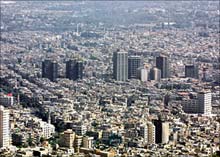 Damascus,
one of the oldest, continuously inhabited cities in the world, is an emerald
oasis resting in the shade of the Ghuta Orchards, quenching its thirst from the
Barada River.
Damascus,
one of the oldest, continuously inhabited cities in the world, is an emerald
oasis resting in the shade of the Ghuta Orchards, quenching its thirst from the
Barada River.
Damascus is a mixture of glorious heritage and modernity. This city stood
proudly against the invaders and resisted the Franks' campaigns that failed to
tarnish its pride.
Damascus witnessed many civilizations and coexisted with them, preserving their
imprints and monuments. Many poets and travelers praised Damascus, fascinated by
its wonders.
Historians called Damascus "Jollaq, Al Fayha, Ash–Sham", attributed to Demshaq
Ibin Canaan. Many others confirmed that it dates back to the time before Ibrahim
Al Khalil.
Damascus is the birthplace of philosophers and great architects who left their
imprints upon the Roman Empire. The architect, Apollodorus the Damascene,
designed the first bridge on the Danube River as well as the great Trojan forums
in Rome, Papinien and Ulpien. Well known men of law also descended from this
part of the world.
Old Damascus is surrounded by a wall and towers, in addition to eight gates, six
of which are attributed to ancient times while the other two are Islamic.
The Umayyad Mosque, with its three minarets and columns of the temple of Jupiter
the Damascene, stand at the heart of the city embracing several historic and
archaeological monuments. Important places such as Sladin mausoleum and schools
such as Al Adelieh, Al Jaqmaqieh (Museum of Arabic Calligraphy) and Al Zaherieh
are all situated to the near north of the mosque. To the south: Azem Palace,
Khan Asa'ad Pasha and Hammam Nur-iddin are other interesting sites. Saint
Hanania church stands to the east of the Old City and Saint Paul church is
situated at Kissan gate named after the Saint who descended in a basket from the
wall and left Damascus for Europe to preach Christianity.
In the west of the Old City, Damascus Ayyubid Citadel stands as well as Takieh
Sulemanieh with its War Museum next to the National Museum.
At the top of Qasyun mountain there is Al Arba'een Shrine where Eve stayed after
her son Cain killed his brother Abel, thus becoming the first victim in history,
as the legend goes.
Many Damascene houses, hammams, khans and historical schools dating back to the
successive Islamic periods are scattered inside Old Damascus in addition to An-Nawfara,
the popular historical café. It has other locations of interest such as Al Assad
National Library, Tishrin War Panorama, the Monument of the Unknown Soldier in
Qasyun Mountain, the Opera, the National Theater, cultural centers as well as
several sport complexes.
The Countryside
Many Summer resorts are scattered around Damascus and are famous for their
wonderful climate, fresh fruits and tasty food. These include Zabadani, Bukein,
Halya, Bloudan, Ayn Al Fijeh, Ma’aloula , Seydnaya, Mua’ret Seydnaya , Jaba’adin
with its historical caves as well as As- Sabboura and Ya’afur with their modern
villas.
Other places of interest:
The National Museum, The Old Town, Damascus viewed from the top of Mount
Qassioun, Straight street, The Hamidieh souk, The Nour Ed- Din hammam.
Ma'alula
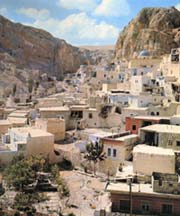 Ma’alula
means (the entrance) in the Aramaic language. It is a rocky village located in
Al – Qalamoon Mountains, in the eastern lower part of Lebanese eastern mountain
, its houses cling on hills of limestone and has two famous monasteries :
Ma’alula
means (the entrance) in the Aramaic language. It is a rocky village located in
Al – Qalamoon Mountains, in the eastern lower part of Lebanese eastern mountain
, its houses cling on hills of limestone and has two famous monasteries :
1. St. Sergius monastery: built in the fourth century A.D and has valuable icons
from the seventeenth and eighteenth centuries in addition to portraits of Arab
saints.
2. St. Tecla monastery: People of all religions venerate the shrine of St. Tecla
who was one of the first saints in Christianity.
Up till now, the people of Ma’aloula still speak the Aramaic, the language of
Jesus Christ.
Saidnaya
Some 30 km from Damascus, the village is spread out over a
hilltop, and is surrounded by vineyards and olive groves. It has a famous
monastery founded in 547, dedicated to the Blessed Virgin.The name of the
village itself, 'Seyda Naya'in Syriac means 'Our Lady'
The monastery contains a portrait of the Virgin believed to have been painted by
St. Luke.
Aleppo
This city is distinguished by its oriental character. It is situated between the
Mediterranean and the Euphrates, where the most important caravans passed
heading to the four corners of the world. It is believed that Aleppo is the most
important inhabited old city.
It was the capital of the Amorite “Yemhad Kingdom” in the third millennium B.C.
It was conquered, built and destroyed many times by a lot of invaders. The city
is surrounded by towers and walls, and it is one of the most beautiful cities in
the world.
Aleppo’s citadel , which overlooks the city, is a magnificent symbol of the
Arabian military architecture, a witness of the great past of the city. Tenth of
kilometers of covered souq run through the old city, the new quarters of Aleppo
are well built, golden colored, and surrounded by nice gardens.
Aleppo is renowned among other Syrian big cities by its delicious food and the
art of good cooking.
It is also the land of oriental music and from it the famous Qudood were
emerged.
This kind of Music is still admired all over the Arab world.
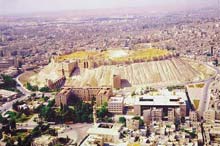 Some
monuments to visit in Aleppo:
Some
monuments to visit in Aleppo:
- The Citadel
- Madrasa, Halawiyeh, and Madrasa El Firdoss
- The Great Mosque.
Other places of interest:
The Museum
The Market
The Old Town
Jdeideh, the Armenian quarter
Ebla
Established in the third millennium B.C. , Ebla became the most important
political and cultural center in Syria between / 2400- 2300 / B.C , which
provoked the jealousy of Sargon so he destroyed it. Soon afterwards, it was
rebuilt once again and regained its strength between /2000 – 1800 / B.C.
There are thousands of cuneiform tablets besides the temples, palaces, quarters,
and the fine sculpture which are living evidences its great civilization.
Saint Simon
15 centuries ago, Emperor Zenon built this important cathedral to honor Saint
Simeon who lived /40/ years on a pillar preaching his students. This church is
an example of the beauty attained by the Syrian architecture and was imitated in
Europe three centuries later .
The middle
region forms a link between all Syrian governorates and is considered an
important agricultural and industrial center. It is distinguished by its history
of a Syrian family from this region who managed to rule in Rome.
All these things made the important poet Juvenal say: "the Orontes river flows
into the Tiber." The oldest irrigation means were invented and still used on
its banks. The water wheels (Norias) still run and send their everlasting
moaning tune.
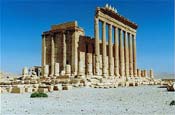 Palmyra
Palmyra
Palmyra city stands as a symbol for its Arab Queen “ Zenobia” who
was an example of the ambitious women. She stood against the greatness and
mightiness of Rome.
Today , Palmyra is famous for its temples, walls and tombs. It is surrounded by
green oasis of olive, palm and pomegranate trees and looks
Like a mirage in a mid vast desert. Brilliant Palmyra is located between the
Mediterranean Sea and the Arab Jazirah and it was an important point on the Silk
Road.
SURROUNDING PALMYRA
The Castle Qasr El-Hir Ash-Sharqi
It was constructed in 728 AD, during the Omayyad period, under the reign of the
Caliph Hisham. Over the 850 hectares of ground in the surrounding area, limited
by a wall of bricks of twenty-two kilometers, agriculture was made possible,
thanks to an irrigation system. This desert observation post constituted a place
of rest where one hunted for leisure. It also allowed the control of the traffic
of goods coming from Persia. The Abbasids also occupied it before it became
definitively abandoned after the Mongol invasions (13th century AD).
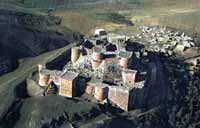 Crac
des Chevaliers
Crac
des Chevaliers
It is the most famous castle of the middle ages. It stands proudly on a volcanic
crater and overlooks the Beka’a plain , Homs and Latakia mountains. This castle
tells the story of two centuries of bloody and wild struggle ended by liberating
it in 1271 by the sultan Al Zaher Baybars who rebuilt its ruined parts and added
many others
Bosra
It was the Roman capital for the Arabic Region and located in the middle of a
Fertile valley. There is a big gate leading
To the city with its old paved roads, the Lively and brilliant colors of
costumes in this city create a strange, charming and amazing contrast with the
dark and gloomy color of the basaltic stones of the temples, palaces , high
columns and mosques dating back to middle ages. In Bosra , there is a
magnificent amphitheater dating back to the second century A.D and can
accommodate up to 15000 audiences.
The coastal
region consists of fertile plains and several bays and caps extending from Ras
Al Bassit in the north (near Alexandrette) to Tartous in the south. At the
western slope of the Latakia mountains, there are a lot of small villages and
ancient citadels besides many old ruins and summer resorts where people enjoy
their mild climate.
 Latakia
Latakia
Built by the Seleucids at the third century B.C. It is
distinguished by its main port, which had been used since the old Roman period.
In Latakia, you can see the Arch of Victory which was built by Septimus Severus
in addition to a beautiful khan which is now the city museum.
Ugarit
It is 12 km from Latakia. The first Alphabet and first written musical note were
discovered in it. Ugarit was a very important commercial center and the capital
for the Canaanites Kingdom at the 2nd. Millennium B.C. The king of Ugarit had a
very big and splendid palace, which was later on,
Made the center for governmental administration. The ruins of this palace are
still the witnesses of the glory of this kingdom and its well organization.
Tartous & Arwad
Antrados (Tartous) and Arados (Arwad isle) have had fraternal life and
historical relations since the old ages. They were renowned for their maritime
and commercial importance. From their shores, the Phoenicians vessels sailed
loaded by the finest goods and delicious spices. To the south of Tartous, you
can see the ruins of Amrit which represent a distinguished temple graved in the
rocks and surrounded by water and a sport playground which had been used by old
Syrian in their sport sea sons 4 century B.C
Marqab citadel
Built in 1062 by Muslims, the "Look-Out Castle" passed over to
the Byzantines in 1104 and to the French Crusaders during its surrender to Roger
of Antioch. The order of the "Hospitaliers" made the fortress bigger in order to
make an impregnable stronghold [end 12th century) which suffered the attacks of
the Arabs after Crac des Chevaliers had fallen into the hands of the latter.
After five months of siege, the sultan Qalaoun took over the stronghold, which
in turn served in the struggle against the Crusaders. A village developed
"intra-muros" then the site fell into oblivion towards the 19th century.
Salah Al Din Citadel
It is 55 km . from Latakia, situated on top of a very slipped
rocky mountain overlooking the surrounding green forests. It was described as
the most impregnable fortress. The Arabian commander Salah Al – Din liberated it
in 1188 A.D and in 1225 the Ambassador of Venice Marine Republic visited it and
signed a commercial treaty with its governor due to its important and strategic
position.
THE VALLEY OF THE ORONTES
Hama
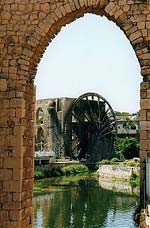 Fifth
town of Syria, one often qualifies Hama as traditionalist due to its religious
conservatism but also romantic with its norias, huge wheels of wood that have
not stopped turning since the 14th century. As small Aramaean town, it was
annexed by the Assyrians in 820 BC. Few monuments resisted the successive
occupations, Seleucid, Roman, Byzantine, and the Arab empires.
Fifth
town of Syria, one often qualifies Hama as traditionalist due to its religious
conservatism but also romantic with its norias, huge wheels of wood that have
not stopped turning since the 14th century. As small Aramaean town, it was
annexed by the Assyrians in 820 BC. Few monuments resisted the successive
occupations, Seleucid, Roman, Byzantine, and the Arab empires.
The Seleucides gave it the name of Epiphania in honor of Antiochos 4th Epiphania,
their leader. Situated practically at the halfway point between Aleppo and
Damascus, Hama was often the object of territorial quarrels between the rival
dynasties of Aleppo and Damscus, especially during the very agitated 11th and
12th centuries. The first norias were constructed during the Ayyubid period, a
period of great prosperity. The Mamelukes and the Ottomans followed the example.
Saladdin developped here an orthodox Sunnism that one finds today in the sharp
traditionalism of its inhabitants.
Apamea (Afamia)
It was built in the fourth century B.C by Seleucus Necator who named it after
his wife Afamia. Many famous personalities visited this city like Antonio and
Cleopatra and Hannibal. A philosophical school of modern Platonic approach was
established in it .
The Romans rebuilt it so the Persian and Roman civilizations were wonderfully
mingled in it. It was a commercial center where trade caravans used to frequent.
It was then destroyed by two severe earthquakes.
You can see a wall surrounding its beautiful ruins such as high columns, old
houses and big churches dating back to the fifth and sixth centuries A.D in
addition to a splendid amphitheatre. Its museum has a lot of extra-ordinary
mosaic panels. Shaizar citadel, dating back to the 13th C., stands proudly over
the nearby hill.
Around Syria:
Lebanon :: recommended website for more information:
Ministry of Tourism
:: Lebanon
Tourism in
Lebanon
Jordan :: recommended website for more information:
Ministry of
Tourism :: Jordan
Visit Jordan
 Damascus,
one of the oldest, continuously inhabited cities in the world, is an emerald
oasis resting in the shade of the Ghuta Orchards, quenching its thirst from the
Barada River.
Damascus,
one of the oldest, continuously inhabited cities in the world, is an emerald
oasis resting in the shade of the Ghuta Orchards, quenching its thirst from the
Barada River.  Ma’alula
means (the entrance) in the Aramaic language. It is a rocky village located in
Al – Qalamoon Mountains, in the eastern lower part of Lebanese eastern mountain
, its houses cling on hills of limestone and has two famous monasteries :
Ma’alula
means (the entrance) in the Aramaic language. It is a rocky village located in
Al – Qalamoon Mountains, in the eastern lower part of Lebanese eastern mountain
, its houses cling on hills of limestone and has two famous monasteries : Some
monuments to visit in Aleppo:
Some
monuments to visit in Aleppo: Palmyra
Palmyra Crac
des Chevaliers
Crac
des Chevaliers Latakia
Latakia Fifth
town of Syria, one often qualifies Hama as traditionalist due to its religious
conservatism but also romantic with its norias, huge wheels of wood that have
not stopped turning since the 14th century. As small Aramaean town, it was
annexed by the Assyrians in 820 BC. Few monuments resisted the successive
occupations, Seleucid, Roman, Byzantine, and the Arab empires.
Fifth
town of Syria, one often qualifies Hama as traditionalist due to its religious
conservatism but also romantic with its norias, huge wheels of wood that have
not stopped turning since the 14th century. As small Aramaean town, it was
annexed by the Assyrians in 820 BC. Few monuments resisted the successive
occupations, Seleucid, Roman, Byzantine, and the Arab empires.